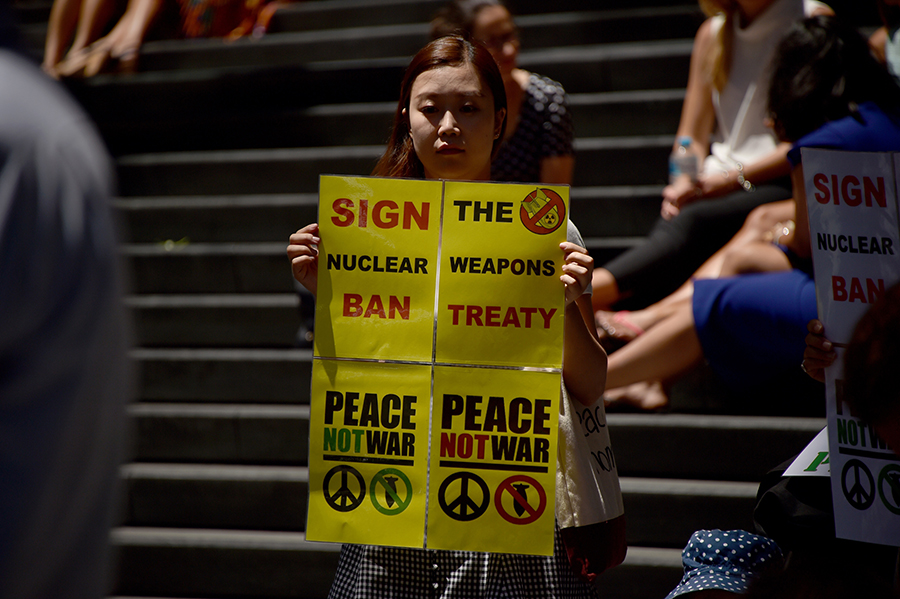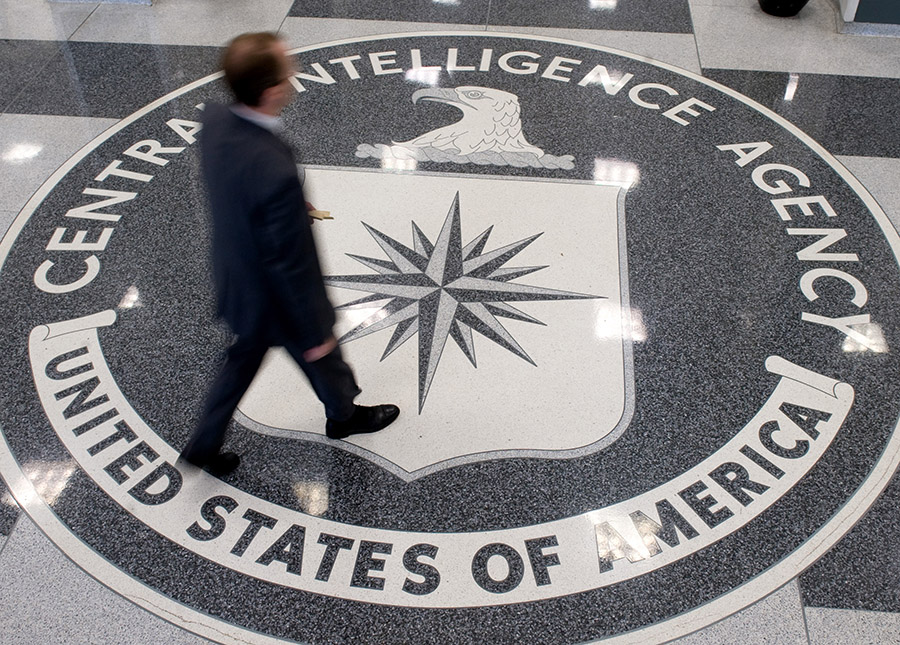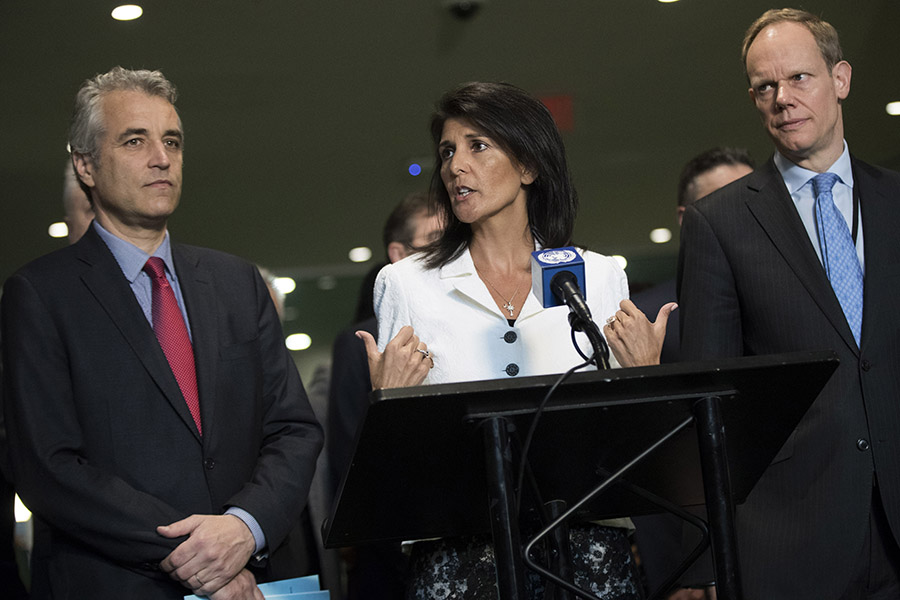The Nuclear Weapons Prohibition Treaty: Interpreting the Ban on Assisting and Encouraging
October 2018
By Stuart Casey-Maslen
The 2017 Treaty on the Prohibition of Nuclear Weapons, which was negotiated by more than 120 states, has changed the conversation about nuclear weapons and their legitimacy.
 The treaty prohibits the development, production, manufacture, acquisition, possession, stockpiling, transfer, stationing, installation and threat of use of nuclear weapons. In so doing, it reinforces states’ commitments to the nuclear Nonproliferation Treaty (NPT) and the Comprehensive Test Ban Treaty (CTBT).
The treaty prohibits the development, production, manufacture, acquisition, possession, stockpiling, transfer, stationing, installation and threat of use of nuclear weapons. In so doing, it reinforces states’ commitments to the nuclear Nonproliferation Treaty (NPT) and the Comprehensive Test Ban Treaty (CTBT).
Additionally, the prohibition treaty has a broad provision that specifically obligates each state-party to never, under any circumstances, “assist, encourage, or induce, in any way, anyone to engage in any activity” prohibited to a state-party under the treaty.1 This key nonassistance provision has attracted considerable discussion because of its implications for countries allied with nuclear weapons possessor states, such as those under the United States’ so-called nuclear umbrella, as well as for non-nuclear-weapon states that have or seek access to nuclear materials and technology for the peaceful use of nuclear energy.
For nuclear-armed states, assistance from other countries is needed not only to maintain but also to modernize their arsenals and even to deploy them operationally in certain parts of the world. This is because, for instance, they require quantities of fissionable material for enrichment or reprocessing, relevant software, and missile technology that may be available from non-nuclear-weapon states. Similarly, they may desire basing permissions for bombers close to where they may be needed in the event of major conflict. The practical significance is that the nuclear-weapon states, mindful that the assistance provision will be an impediment to the effectiveness and legitimacy of their weapons stockpiles, are using their considerable influence to discourage countries from joining the treaty.
Further, there are concerns among some non-nuclear-weapon states about the reach of the provision. For instance, early in the main session of the 2017 UN diplomatic conference that negotiated the treaty, the Netherlands, where the United States reportedly stores tactical nuclear bombs,2 called for “assist,” “encourage,” and “induce” to be defined.3 Singapore subsequently stated that the provision was “not clear.”4 One concern is whether unrelated commercial trade might be adversely affected by the provision. This article explores the extent to which these concerns are legally justified.
Prohibitions in Disarmament Law
A clause outlawing different forms of assistance for prohibited activities has been a staple of comprehensive disarmament treaties—those that prohibit the possession and transfer of weapons and require the destruction of any stockpiles—since 1972, with the adoption of the Biological Weapons Convention (BWC).5 Prior even to that, the NPT included a nonassistance clause,6 although its scope of application was limited to the nuclear-weapon states named under that treaty, essentially the five permanent members of the UN Security Council.7
The precise framing of the assistance provision in comprehensive disarmament treaties has barely changed since the 1992 Chemical Weapons Convention (CWC),8 which had broadened the scope of the undertaking to encompass natural and legal persons (individuals and corporate entities). The BWC had prohibited assisting only other states and international organizations. Since the opening of the CWC, its formulation of the assistance provision has been employed most often, including in the wording for the nuclear weapons prohibition treaty. In contrast, in the 2008 Convention on Cluster Munitions, negotiators omitted the words “in any way” as a number of NATO members wished to leave open the possibility of joint planning with the United States for the use of cluster munitions.
Scope of the Prohibition
The scope of the undertaking is certainly broad. The words “in any way” mean that the prohibition encompasses indirect and direct actions. As such, it would cover supply of the key components of any nuclear explosive device, at least where there was knowledge on the part of the state-party of the recipient’s intent to use them in a nuclear weapon. In this regard, under the Draft Articles on State Responsibility for violations of international law (“internationally wrongful acts”) finalized by the International Law Commission in 2001, “[a] State which aids or assists another State in the commission of an internationally wrongful act by the latter is internationally responsible for doing so if … that State does so with knowledge of the circumstances of the internationally wrongful act.”9
The word “anyone” in the prohibition on assistance in the ban treaty applies to any recipient of assistance whatsoever. In addition to any other state, this therefore concerns helping any individual, company, or international organization, as well as any nonstate actor, thereby buttressing UN Security Council Resolution 1540.10
 The activities prohibited for a state-party under the ban treaty are those set out in the other subparagraphs of Article 1(1) of the treaty, namely to develop, test, produce, manufacture, otherwise acquire, possess, or stockpile nuclear explosive devices; to transfer them to any recipient directly or indirectly; to receive their transfer or control over them; and to use or threaten to use or allow any stationing of such devices in any place under their jurisdiction or control. A state-party can therefore not help anyone to develop or obtain nuclear weapons or control over them or to pass them on to any other party.
The activities prohibited for a state-party under the ban treaty are those set out in the other subparagraphs of Article 1(1) of the treaty, namely to develop, test, produce, manufacture, otherwise acquire, possess, or stockpile nuclear explosive devices; to transfer them to any recipient directly or indirectly; to receive their transfer or control over them; and to use or threaten to use or allow any stationing of such devices in any place under their jurisdiction or control. A state-party can therefore not help anyone to develop or obtain nuclear weapons or control over them or to pass them on to any other party.
What is the nature of the prohibition on assisting such activities? The notion of unlawful assistance is well known in public international law under the rules of state responsibility.
Under the rules referenced above, one state assists another to commit a violation of international law if it does so with knowledge of the circumstances of the other state’s violation and if the act by the recipient state that amounted to the violation would be a violation had it committed the act itself. With regard to the prohibition treaty, of course, there is a slight distinction insofar as the state receiving the assistance might not be party to the treaty and therefore might not itself be violating international law, but the same principles of nonassistance apply. Under Article 1(1)(e), state-party A cannot assist state B (irrespective of whether it has joined the treaty) to develop, produce, or stockpile any nuclear explosive device. An obvious instance of unlawful assistance would be the supply of fissile material or related technology, where the supplying state-party knows the use to which such material or know-how will be put.
Where it was known that the missile program of the assisted recipient was intended for the delivery of nuclear weapons, the provision of ballistic missile technology would also be unlawful. Jointly planning with a nuclear-weapon state that is about to test or use nuclear weapons on how and where a weapon will be detonated would be another clear case of a violation. Evidently, too, a state-party that allows a nuclear-weapon state to deploy its nuclear weapons on its territory would be engaging in prohibited assistance for the possession and probably also stockpiling of the weapons. In any event, the act of allowing the stationing, installation, or deployment of any nuclear weapons on a state-party’s territory is explicitly outlawed by Article 1(1)(g).
Also, it would be unlawful to gather and share intelligence to be used for the purpose of targeting nuclear weapons. One example might involve so-called Five Eyes, the intelligence alliance of Australia, Canada, New Zealand, the United Kingdom, and the United States.11 Its work to prevent the proliferation of nuclear weapons is lawful, but intelligence used to assist the UK or the United States in identifying sites to be hit with nuclear weapons, such as in North Korea, would clearly breach the assistance provision. That would amount to a significant treaty violation if the intelligence came from a state-party.
The NATO Issue
The prohibition on encouraging prohibited activities concerns, in particular, members of nuclear alliances, most obviously those states belonging to NATO. The preface to the alliance’s latest “strategic concept,” adopted in November 2010, commits NATO to “the goal of creating the conditions for a world without nuclear weapons” but “reconfirms that, as long as there are nuclear weapons in the world, NATO will remain a nuclear alliance.”12 The strategic concept further recalls that “[d]eterrence, based on an appropriate mix of nuclear and conventional capabilities, remains a core element of our overall strategy. The circumstances in which any use of nuclear weapons might have to be contemplated are extremely remote. As long as nuclear weapons exist, NATO will remain a nuclear alliance.”13
It is certainly lawful for a member of NATO to sign the prohibition treaty, but would it also be lawful for a member state to ratify or accede to the treaty and become a state-party? The Netherlands, for one, says it cannot support the treaty because it is “incompatible” with its NATO obligations.14
The notion of encouragement covers efforts to persuade someone to do something or to continue to do it, whether or not those efforts are successful. NATO’s 2010 strategic concept explicitly envisages the possession and potential use by certain members of a nuclear alliance. Indeed, the strategic concept stipulates that NATO will “maintain an appropriate mix of nuclear and conventional forces.” As observed in April 2018,
[i]t is difficult not to read the current Strategic Concept as an “encouragement” of the nuclear-armed allies’ continued retention of nuclear weapons. In France, the United Kingdom, and the United States, increased spending on nuclear weapons is frequently justified as a means of “reassuring” allies or meeting “extended deterrence commitments.” The language contained in the Strategic Concept enables such justifications and, by extension, the development and possession of nuclear weapons. The language of NATO’s current Strategic Concept appears incompatible with Article 1(1)(e).15
At the same time, adhering to an international treaty overrides, as a matter of international law, commitment to an earlier political declaration or instrument, which is the nature of the 2010 NATO strategic concept. Indeed, there is a certain irony in the position that a nuclear-weapon state may adhere to the prohibition treaty and be in conformity with it, subject to its compliance with the obligations to not use or threaten to use nuclear weapons, to remove them from operational status, and then to destroy them,16 but an umbrella state would be in violation the moment it joined.
That said, it would be straightforward for a nuclear umbrella state to openly disavow support for nuclear weapons and then to comply with the rest of the treaty as would any other state-party. This would represent good faith application of the treaty, as the law of treaties demands of all states-parties to any treaty. Furthermore, “NATO members are not obliged to endorse every line of alliance language. There is a long tradition of member states’ ‘footnoting’ or attaching interpretative statements to alliance documents.”17
 Moreover, as was the case with the 1997 Mine Ban Treaty, there is no problem in “merely” participating in military maneuvers with states that possess the prohibited weapons as long as those maneuvers do not rise to the level of assistance or encouragement to possess or use the weapons. For example, were Sweden to adhere to the prohibition treaty, it could lawfully pursue military exercises such as Aurora 17, which took place in Sweden in September 2017 with the participation of the United States and other NATO states.18
Moreover, as was the case with the 1997 Mine Ban Treaty, there is no problem in “merely” participating in military maneuvers with states that possess the prohibited weapons as long as those maneuvers do not rise to the level of assistance or encouragement to possess or use the weapons. For example, were Sweden to adhere to the prohibition treaty, it could lawfully pursue military exercises such as Aurora 17, which took place in Sweden in September 2017 with the participation of the United States and other NATO states.18
In 2016, prior to the negotiation of the treaty, the United States drafted a diplomatic discussion document, a so-called nonpaper, on the ramifications it foresaw of the future treaty.19 In it, the United States argued that the future treaty “could” degrade security relationships and “delegitimize the concept of nuclear deterrence.” More substantively and with specific respect to the assistance provision, the United States argued that the treaty could force a signatory, presumably a state-party, to “repudiate” U.S. statements that “it would defend the signatory with nuclear means.”20
This is an accurate assessment of Article 1(1)(e), but the nonpaper also suggested that a state-party could believe that it was “legally required” to “block all NATO nuclear cooperation” even if it were not involved in any nuclear “burden-sharing.”21 This is clearly wrong. A state-party to a treaty is bound to comply with its own obligations, not to impose disarmament on other states. To “assist” or “encourage” does not mean to “permit.” Perhaps what is most interesting about this nonpaper is the implicit recognition that a state-party to the treaty is not obligated to withdraw from NATO.
Conclusion
In sum, the prohibition treaty precludes states-parties from assisting or encouraging the possession, transfer, or use of any nuclear explosive devices, for instance by providing technological know-how for development or fissile material for production or by endorsing declarations by regional organizations calling for the maintenance of a nuclear deterrent.
Yet, it does not stop states-parties from generally collaborating with other states in military affairs and operations or from being a member of a regional organization, some of whose members possess nuclear weapons. This is the position of the International Human Rights Clinic at Harvard Law School. In a recent, thoughtful paper, the clinic argues that the prohibition treaty requires a state-party “to renounce its nuclear umbrella status, but does not stand in the way of alliances with states that continue to possess nuclear weapons.”22
The prohibition on assistance is broad in scope, requiring explicit disavowal of any existing nuclear-umbrella guarantee, but realistic in application. It is an integral component of the prohibition of nuclear weapons.
ENDNOTES
1. Treaty on the Prohibition of Nuclear Weapons (TPNW), 2017, art. 1(1)(e), https://treaties.un.org/doc/Treaties/2017/07/20170707%2003-42%20PM/Ch_XXVI_9.pdf.
2. Hans M. Kristensen and Robert S. Norris, “Worldwide Deployment of Nuclear Weapons, 2017,” Bulletin of the Atomic Scientists, Vol. 73, No. 5 (Aug. 31, 2017), pp. 289-297.
3. Remarks of the Netherlands in plenary, Second Session of the United Nations Conference to Negotiate a Legally Binding Instrument to Prohibit Nuclear Weapons, Leading Towards their Total Elimination, 16 June 2017 (notes on file with author).
4. Remarks of Singapore in plenary, Second Session of the United Nations Conference to Negotiate a Legally Binding Instrument to Prohibit Nuclear Weapons, Leading Towards their Total Elimination, 16 June 2017 (notes on file with author).
5. Convention on the Prohibition of the Development, Production and Stockpiling of Bacteriological (Biological) and Toxin Weapons and on Their Destruction art. III, April 10, 1972, 1015 U.N.T.S. 163.
6. “Each nuclear-weapon State Party to the Treaty undertakes … not in any way to assist, encourage, or induce any non-nuclear-weapon State to manufacture or otherwise acquire nuclear weapons or other nuclear explosive devices.” Treaty on the Non-Proliferation of Nuclear Weapons art. I, July 1, 1968, 729 U.N.T.S. 168 (hereinafter NPT).
7. “For the purposes of this Treaty, a nuclear-weapon State is one which has manufactured and exploded a nuclear weapon or other nuclear explosive device prior to 1 January, 1967.” NPT, art. IX(3).
8. Convention on the Prohibition of the Development, Production, Stockpiling and Use of Chemical Weapons and on their Destruction art. I(1)(d), January 13, 1993, 1974 U.N.T.S. 45.
9. International Law Commission, Report on the work of its fifty-third session, A/56/10, 2001, art. 16 (“Aid or assistance in the commission of an internationally wrongful act”).
10. The UN Security Council, acting under Chapter VII of the UN Charter, decided that “all States shall refrain from providing any form of support to non-State actors that attempt to develop, acquire, manufacture, possess, transport, transfer or use nuclear, chemical or biological weapons and their means of delivery.” UN Security Council, S/RES/1540, April 28, 2004.
11. See, e.g., Yusra Aziz, “The Five Eyes Intelligence Alliance,” Privacy End, March 16, 2018, https://www.privacyend.com/five-eyes-intelligence-alliance/.
12. NATO, “Active Engagement, Modern Defence: Strategic Concept for the Defence and Security of the Members of the North Atlantic Treaty Organization,” November 19, 2010, https://www.nato.int/nato_static_fl2014/assets/pdf/pdf_publications/20120214_strategic-concept-2010-eng.pdf.
14. Kingdom of the Netherlands, “Explanation of Vote of the Netherlands on Text of Nuclear Ban Treaty,” July 7, 2017, https://www.permanentrepresentations.nl/latest/news/2017/07/07/explanation-of-vote-of-ambassador-lise-gregoire-on-the-draft-text-of-the-nuclear-ban-treaty.
15. “Nuclear Weapons Ban Monitor: Preliminary Research,” Norwegian People’s Aid and International Campaign to Abolish Nuclear Weapons, May 2018, p. 26, http://www.icanw.org/wp-content/uploads/2018/05/Nuclear-Weapons-Ban-Monitor.pdf.
16. See TPNW, arts. 1, 2, and 4.
17. “Nuclear Weapons Ban Monitor,” p. 26.
18. With respect to Sweden, see Bonnie Docherty, “The Treaty on the Prohibition of Nuclear Weapons and Its Compatibility With Sweden’s Security Arrangements,” International Human Rights Clinic, Harvard Law School, June 2018, http://hrp.law.harvard.edu/wp-content/uploads/2018/05/Sweden_TPNW.pdf.
19. NATO, “United States Non-Paper: ‘Defense Impacts of Potential United Nations General Assembly Nuclear Weapons Ban Treaty; Note by the Secretary,’” AC/333-N(2016)0029 (INV), October 17, 2016, annex 2, http://www.icanw.org/wp-content/uploads/2016/10/NATO_OCT2016.pdf.
22. International Human Rights Clinic, “Nuclear Umbrella Arrangements and the Treaty on the Prohibition of Nuclear Weapons,” Harvard Law School, June 2018, p. 1, http://hrp.law.harvard.edu/wp-content/uploads/2018/06/Nuclear_Umbrella_Arrangements_Treaty_Prohibition.pdf.
Stuart Casey-Maslen is research and policy coordinator at the International Campaign to Abolish Nuclear Weapons. He was co-editor of Nuclear Weapons Under International Law (2014).
